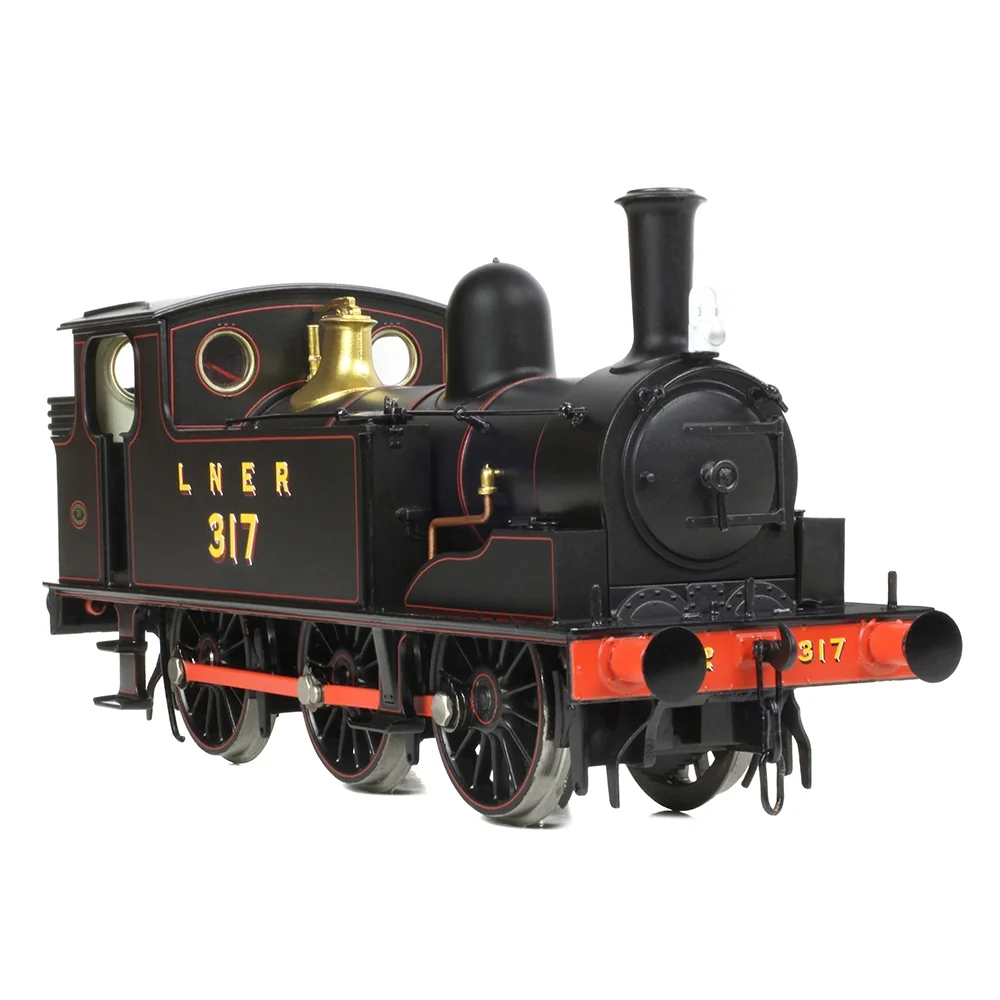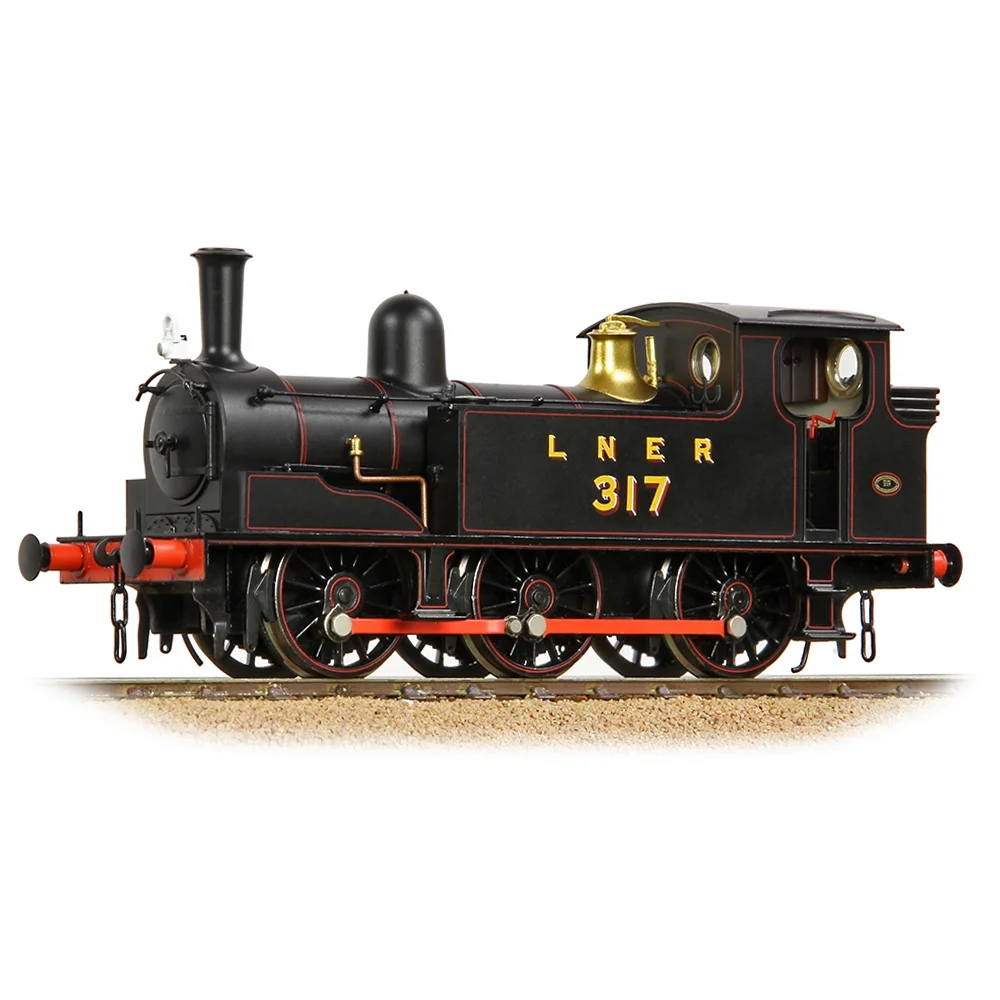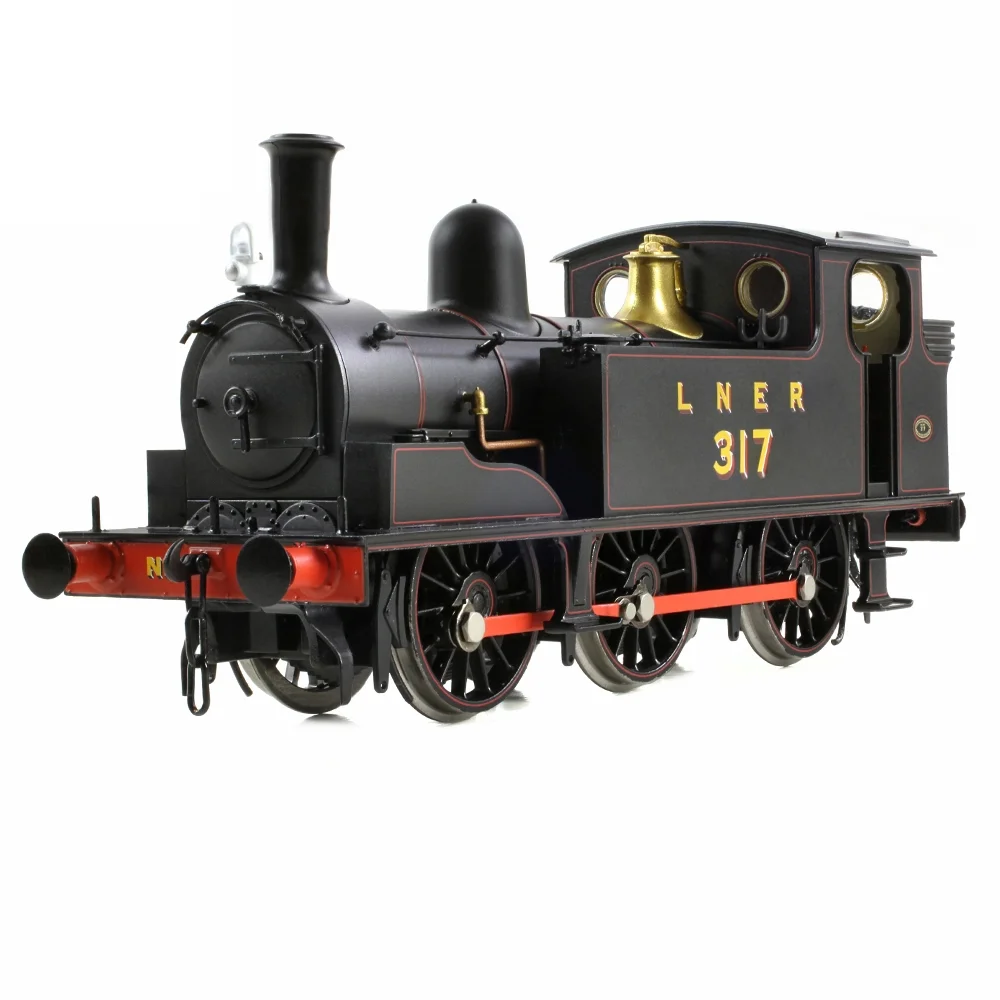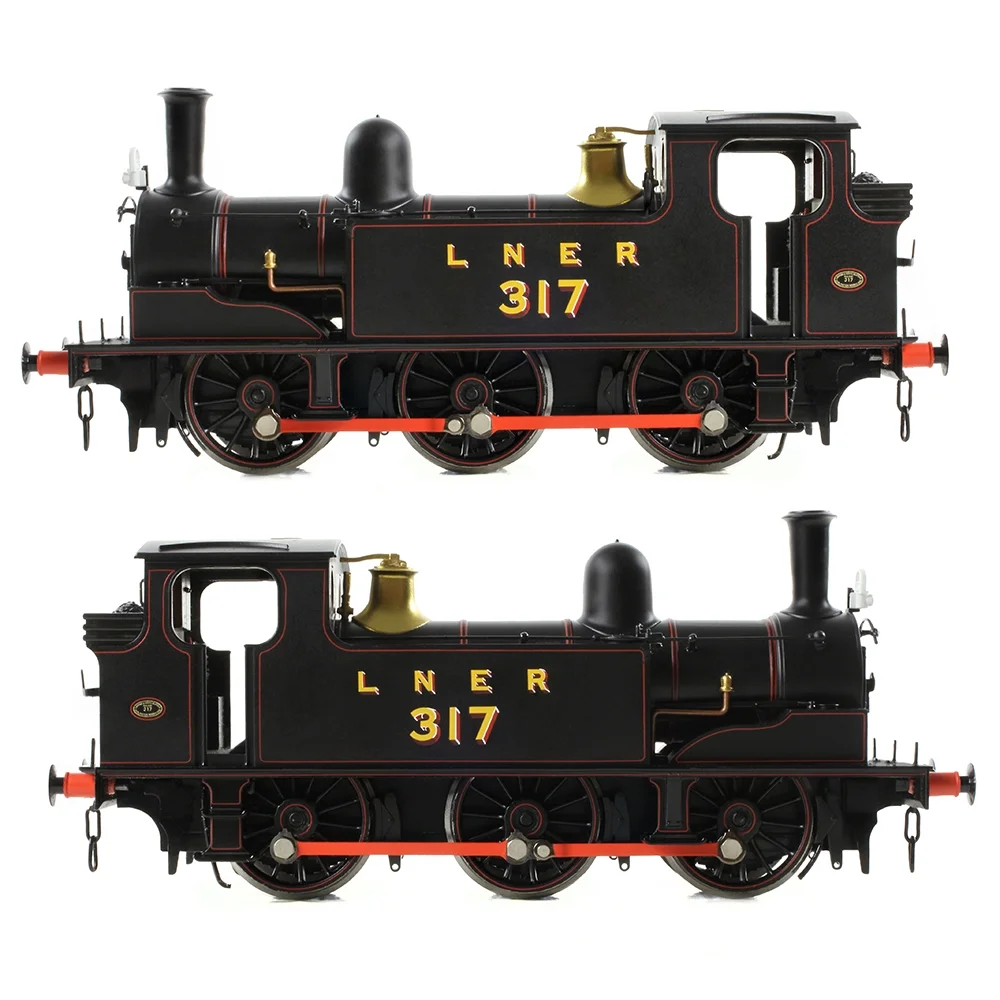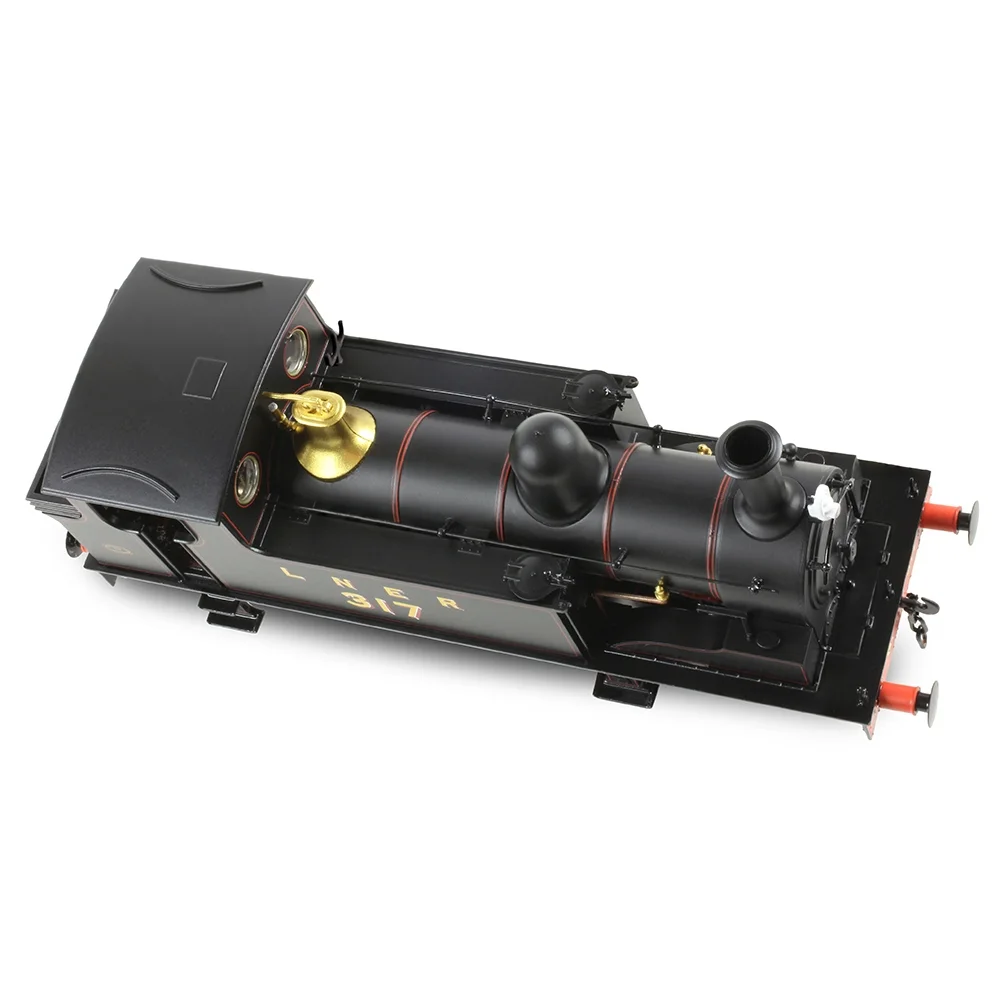Bachmann 31-066
London & North Eastern Railway J71 317 London & North Eastern Railway Lined Black
Bachmann's Description & Specifications
The North Eastern Railway E Class 0-6-0T, later the LNER J71, was the forerunner to the E1 (LNER J72) and whilst models of the E1 have famously been made by Bachmann and its predecessor Mainline Railways for almost 50 years, the NER E Class has never been produced in OO Scale, until now!
Drawing inspiration from the all-new Branchline E1 model that was launched to great acclaim just a few years ago, the new E Class employs a wealth of new tooling to accurately depict the NER’s original standard 0-6-0 tank locomotive. Despite the similarities, the E Class is instantly recognisable thanks to its larger driving wheels, while the smaller bunker means that the tanks, cab and bunker on this Branchline model are all-new too. Then there is the original boiler with clack valves and Ramsbottom safety valves – another early feature that necessitates its own, dedicated tooling.
The model boasts a diecast metal running plate with integral tank weights, again produced new for the E Class to portray the differences seen between the E and E1, and to this the precision moulded components are added, from the tanks to the boiler and many smaller details alongside. Metal parts are then used to replicate features like the lamp irons, guard irons and sand pipes, and the handrails are made from metal wire which is fitted into turned metal knobs.
Inside, the Branchline E Class employs a coreless motor with diecast gearbox and the driving axles each have separate metal bearings, a combination that ensures smooth and reliable running. With electrical pickup from all wheels, a firebox lighting system and Next18 DCC interface, plus a pre-fitted speaker in every model, the E Class boasts the same impressive technical specification as its E1 relative. Whilst the drive train and electronics may not be visible, every part of the model that can be seen is treated to an exquisite paint finish to complete the look, with rich colours and precision printing of the numbering and lettering to produce a model as elegant as its Victorian prototype.
- Bachmann Branchline OO Scale
- Era 3
- Pristine LNER Lined Black Livery
- Running No. 317
- Equipped with a Next18 DCC Decoder Socket – Recommend Decoder item No. 36-567A
- Length 118mm (over couplings)
- Part of our Railway Celebrations range
Bachmann's LNER Livery Choice: Despite never receiving an LNER number, Bachmann has modelled No. 317 in LNER livery because by 1925 (the year of its centenary fame), the locomotive would have been repainted in LNER's corporate colours following the 1923 Grouping. The LNER inherited the NER in 1923 and began applying their standard livery schemes to former NER locomotives, even while retaining original numbers. No. 317's appearance at the centenary celebrations would therefore have been in LNER livery bearing its original NER number - exactly as Bachmann has modelled it.
DETAIL VARIATIONS SPECIFIC TO THIS MODEL
- Boiler Clack Valves
- Ramsbottom Safety Valves
- Pipe Whistle
- Steam Brakes Only
- Plain Smokebox Door
- Smokebox Door Handwheel
- Parallel Shank Buffers with Round Mounts
- Coal Bunker with Coal Rails fitted
- Rear Cab Windows without Bars
Model Significance: This represents the locomotive at its most historically significant moment - the 1925 centenary celebrations that made it a railway heritage icon.
MECHANISM:
- Coreless motor
- Electrical pickup from all wheels
- Separate metal bearings fitted to each driving axle
- Diecast metal chassis block
- Diecast metal gearbox, with gearing arranged for prototypical running speeds and haulage capabilities
- 5mm (OO gauge) wheels to NEM310 & NEM311 standards with authentic profile and detailing
- Detachable coupling pockets to NEM362 standards fitted at each end
- Designed to operate on curves of second radius (438mm) or greater
DETAILING:
- Diecast metal running plate with integral side tank weights
- Precision moulded plastic boiler, side tanks, cab and bunker
- Separately applied details including splashers, tank filler hatches, safety valves, dome and chimney, smokebox handles, clack valves* and vacuum pipes* (*where applicable)
- Individual metal detail components including handrails, handrail knobs, guard irons, lamp irons and turned metal whistle
- Highly detailed and decorated cab interior including controls, dials, gauges and tool cabinets with separately fitted regulator, reverser and handbrake
- Running gear detailing includes springs, brakes and separately fitted brake gear, sandboxes and sandpipes
- Glazed cab spectacles
- Sprung metal buffers
- Each model supplied with an accessory pack including cab doors, additional bufferbeam pipework, poseable lamps and three-link couplings
LIGHTING:
- Firebox Glow (on analogue) / Firebox Glow & Flicker (on DCC or when SOUND FITTED models are used on analogue)
DCC:
- Next18 DCC decoder interface
SOUND:
- Speaker installed in all models for optimum sound reproduction
- ESU Loksound Micro V5DCC Sound Decoder fitted to SOUND FITTED versions
- Sound files produced specifically for the Bachmann Branchline J71 using recordings from real locomotives
- SOUND FITTED models operate on DCC and Analogue control as supplied
LIVERY APPLICATION:
- Authentic liveries applied to all models
- Multiple paint applications employed on each model
- Logos, numerals and text added as appropriate using multi-stage tampo printing incorporating authentic typefaces, logos and colours
Class & Prototype
- Class: London & North Eastern Railway J71
- Traction: Steam
- Built: 1886-1895
- Total Built: 120
- Running Number: 317
- Ordered By: North Eastern Railway
- Built By: North Eastern Railway
- Built At: Darlington
- Built: 12/1886
- Withdrawn: 05/1936
- Length of Service: 49.4 years
- Running Numbers: NER 317
- Names: -
The North Eastern Railway Class E was T.W. Worsdell's highly successful 0-6-0T shunting locomotive, introduced in 1886 to replace aging Fletcher saddle tanks. With 120 built at Darlington Works between 1886-1895, these compact side-tank engines became the backbone of NER freight operations from Durham coalfields to Tyne docks.
Featuring 4ft 7¼in driving wheels, 16in × 22in inside cylinders, and 140 psi boiler pressure, the Class E prioritized reliability over complexity with simple Stephenson valve gear. The design proved exceptionally durable - the last example served 74 years until 1961, making it one of Britain's longest-serving locomotive classes.
Under the LNER they became Class J71, with 81 surviving to British Railways as numbers 68230-68316. Their robust design directly inspired the famous J72 class, creating a locomotive lineage spanning 1886-1951.
Built in December 1886 at Darlington Works as one of the earliest Class E locomotives, No. 317 achieved lasting historical fame through its starring role in the 1925 Stockton & Darlington Railway Centenary Celebrations. This locomotive was specifically selected to represent the North Eastern Railway's contribution to British railway heritage during this prestigious national commemoration marking 100 years since the opening of the world's first passenger railway.
The locomotive's participation in the 1925 centenary made it one of the most photographed and documented Class E locomotives of its era, providing valuable visual records of both the locomotive and the celebration itself. This high-profile appearance elevated No. 317 from an ordinary shunting engine to a symbol of railway heritage and progress.
Operationally, No. 317 served for 49.4 years before withdrawal in May 1936 - notably, it was withdrawn before the LNER's 1946 renumbering scheme that gave surviving Class E locomotives their 8200-series numbers. This means No. 317 never carried an LNER number, remaining "NER 317" throughout its entire service life.
Operator & Livery
- Operator: London & North Eastern Railway
- Livery: Lined Black
- Era: 3 - The big 4 – LMS, GWR, LNER & SR
The London & North Eastern Railway emerged in 1923 as Britain's second-largest railway company, combining seven major railways including the Great Northern, North Eastern, and Great Eastern into a 6,590-mile network stretching from London's four terminals to the Scottish Highlands. Despite serving economically challenged industrial regions, the LNER achieved worldwide recognition for engineering excellence and speed records that remain unbroken today.
Under Chief Mechanical Engineers Sir Nigel Gresley, Edward Thompson, and Arthur Peppercorn, the LNER developed revolutionary locomotive designs characterised by three-cylinder layouts and streamlined aesthetics. Gresley's masterpieces included the A1 Pacifics featuring Flying Scotsman and the legendary A4 class, culminating in Mallard's world steam speed record of 126 mph in 1938.
The company pioneered luxury express services including the Silver Jubilee and Coronation streamliners, whilst investing in forward-thinking electrification schemes and massive marshalling yards. Notable achievements included operating the complete East Coast Main Line, introducing Britain's first regular 400-mile non-stop service, and commissioning Eric Gill's iconic typography that influenced railway design for decades.
Nationalised in 1948, LNER locomotives continued serving British Railways until the 1960s, with some A4 Pacifics working Scottish expresses until 1966. Today, the LNER's engineering legacy thrives through extensive preservation, new-build projects like Tornado, and comprehensive model ranges covering every major class in all popular scales, making LNER subjects essential for discerning railway modellers seeking authentic British steam-age atmosphere.
The LNER lined black livery represented the company's commitment to aesthetic excellence across all locomotive types during the early period of its existence. Introduced from 1923, this elegant scheme adorned freight engines and secondary passenger locomotives with distinctive red lining that transformed utilitarian workhorses into smart, professionally finished machines. The red lines were carefully applied to running plates, boiler bands, and cab panels, following the locomotive's mechanical contours and emphasising engineering features whilst maintaining the practical benefits of a dark base colour for heavy-duty operations.
Distinctive features of this livery included yellow lettering and numbering with red shading (contrasting with the gold used on prestigious green passenger locomotives), and "L N E R" applied in full to tenders. The lined black scheme demonstrated the LNER's philosophy that even freight locomotives deserved visual dignity and corporate identity. However, economic pressures forced changes to this refined approach: red lining was removed from goods engines as an economy measure in 1928, though secondary passenger locomotives retained their lined finish until 1941. For model railway enthusiasts, this livery perfectly captures the LNER's early optimism and attention to detail, making it ideal for depicting 1920s freight operations, mixed-traffic locomotives, and the period when the newly-formed company took pride in presenting a cohesive, quality image across its entire 6,300-locomotive fleet.

